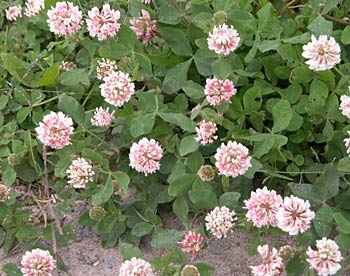Relatives
Trifolium hybridum L. - Alsike.
Taxonomic position.
Family Leguminosae Endl., genus Trifolium L., sect. Lotoiden (L.) D. E. Coombe.Synonyms.
Swedish Clove, Hybrid Clover.Biology and morphology.
Perennial short-lived herb. Tap root with many lateral branches. Erect to decumbent growth habit with many hollow branched stems, 50-60 cm, emanating from a basal crown. Leaves trifoliate, leaflets 1 to 3 cm long, 1 to 1.5 cm wide, glabrous, obovate, the margins finely sharp-toothed, without the leaflet markings typical of red clover. Hairless stipules at the base of the peduncles taper to a point. Inflorescences axillary and borne on longer stalks than the leaves. The globular racemes bearing 30-50 florets, 6-l0 mm, bracts absent. Calyx short and petals not fused into a tube as in red clover. Flowers 5 to 10 mm long, white becoming pink and finally brown and reflexed in age. Two to four smooth, heart-shaped seeds, l mm long, in short, broad pods, green to greenish-brown, but darkening almost to black with age. Blossoms - May-September, seed ripening - June-October. Cross-pollinated by honey bees. 2n = 16.Distribution.
Mainly distributed in the cool temperate and sub-arctic zones of Europe, the Americas and Asia. Widely cultivated throughout the northern temperate zone and escaped, thus the native range is obscured. Perhaps native to Mediterranean countries and Asia Minor. European part of the NIS, Crimea, Caucasus, South-eastern Kazakhstan, Siberia, Far East, Sakhalin.Ecology.
Damp meadows, pastures, roadsides, fields. Adapted to a wide range of environments but grows best in cool rather than warm temperate conditions.Utilization and economic value.
Suitable species in mixture with a non-competitive grass such as timothy for hay production. Generally regarded as having a similar feeding value to red clover at equivalent stages of growth. Has a high protein content. Highly acceptable forage to livestock either as hay or when grazed at a young, leafy growth stage. Tolerates infertile, wet, acid soils better than red clover but growth responds favourably to improved soil fertility; also reasonably tolerant of alkaline soils.Literature:
Brezhnev D. D., Korovina O. N. 1980. Wild relatives of the cultivated plants of flora of the USSR. - L.: Kolos, 376 pp. (in Russian).Flora of Central Siberia. 1979. Malyshev L.I., Peshkova G.A. (ed.). - Novosibirsk: Nauka, Vol. 2. - 1046 pp. (in Russian).
Flora of cultivated plants. Trifolium, Lotus. 1993. Mukhina N. A., A. K. Stankevich (ed.). - M..: Kolos, Vol. XIII. - 334 pp. (in Russin).
Flora of the European part of the USSR. 1987. Phyodorov A. A. (ed.). Vol. VI. - 254 pp. (in Russian).
Flora of the North-East European part of the USSR. - Л., 1974, 1976, 1977. Т. 1-4. (in Russian).
Flora of Siberia. 1994. Polozhiy A.B., Malyshev L.I., (ed.). - Novosibirsk: Nauka, Vol. 9. - 280 pp. (in Russian).
Flora of the USSR, 1945. Schischkin V.K., E.G. Bobrov (ed.). Vol. 11, M.-L.: AN USSR , 430 pp. (in Russian).
Galushko A. I. 1980. Flora of Northern Caucasus. A field guide. - Rostov - na - Donu:, Vol. 2. - 350 pp. (in Russian).
Grossheim A. A. 1952. Genus Trifolium. Flora of the Caucasus. M.-L.: AN USSR, v.5 - p. 191 - 221. (in Russian).
Hulten, Eric and Magnus Fries. 1986. Atlas of north European vascular plants north of the Tropic of Cancer.
Meusel Y. und and.1965. Vergleichende Chorologie der Zentraleuropischen Flora. Jena:, - 583 s.
Plants of Asia Minor. A field guide. 1981. A. I. Vvedenskiy (ed.). - Tashkent: Fan, Vol. VI. - 394 pp.


